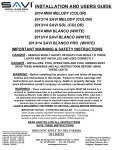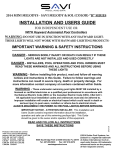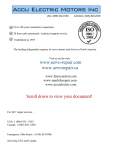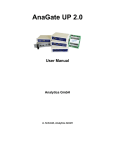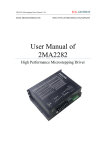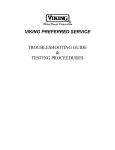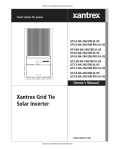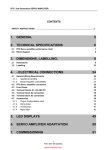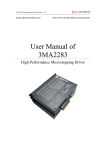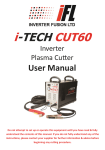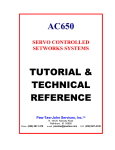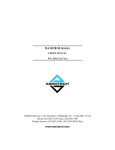Download ds160 series servo and dsr/dsrf rack
Transcript
DS160 SERIES SERVO AND DSR/DSRF RACK USER’S MANUAL P/N: EDA119 (V1.1) AEROTECH, Inc. • 101 Zeta Drive • Pittsburgh, PA. 15238-2897 • USA Phone (412) 963-7470 • Fax (412) 963-7459 Product Service: (412) 967-6440; (412) 967-6870 (Fax) www.aerotechinc.com If you should have any questions about the DS160 Series Servo Amplifier, the DSR/DSRF racks, or comments regarding the documentation, please refer to Aerotech online at: http://www.aerotechinc.com. For your convenience, a product registration form is available at our web site. Our web site is continually updated with new product information, free downloadable software and special pricing on selected products. DS160 Series Servo Amplifiers and DSR/DSRF racks are products of Aerotech, Inc. DS160 Series Servo Amplifier Manual Revision History: Rev 1.0 Rev 1.1 November, 1990 September 28, 2000 DS160 Series User’s Manual Table of Contents TABLE OF CONTENTS CHAPTER 1: 1.1. DESCRIPTION ................................................................................ 1-1 Introduction ........................................................................................ 1-1 CHAPTER 2: 2.1. 2.2. 2.3. 2.4. 2.5. 2.6. 2.7. 2.8. 2.9. 2.10. 2.11. 2.12. DS160 SERVO AMPLIFIER MODULE........................................ 2-1 Introduction ........................................................................................ 2-1 Mounting Specifications..................................................................... 2-1 Power and Control Connections ......................................................... 2-2 Electrical Specifications ..................................................................... 2-4 Fault Output........................................................................................ 2-4 Personality Module............................................................................. 2-5 Control Modes.................................................................................... 2-5 Setting the Current Limit .................................................................... 2-8 Pre-Amplifier Gain Characteristics..................................................... 2-8 The Post-Amplifier ............................................................................. 2-8 Wiring DS160 into A System ............................................................. 2-8 Troubleshooting the DS160 Series ................................................... 2-13 CHAPTER 3: 3.1. 3.2. 3.3. 3.4. 3.5. 3.6. 3.7. 3.8. 3.9. 3.10. 3.11. 3.12. DSR AND DSRF MOUNTING RACKS ........................................ 3-1 Introduction ........................................................................................ 3-1 Three-Axis Mounting Rack (DSR)..................................................... 3-1 Shunt Regulator .................................................................................. 3-1 Control & Power Connections to Mounting Racks............................. 3-1 Six-Axis Mounting Rack (DSRF)....................................................... 3-3 Mounting Specifications..................................................................... 3-3 Electrical Specifications ..................................................................... 3-6 Functional Diagram ............................................................................ 3-8 Wiring DSR/DSRF into System ....................................................... 3-11 The TV 2.5 DC Bus Power Transformer.......................................... 3-11 Troubleshooting................................................................................ 3-17 DSR & DSRF Spare Parts ................................................................ 3-18 APPENDIX A: WARRANTY AND FIELD SERVICE POLICY.......................... A-1 INDEX ∇ ∇ ∇ Version 1.1 Aerotech, Inc. iii Table of Contents iv DS160 Series User’s Manual Aerotech, Inc. Version 1.1 DS160 Series User’s Manual List of Figures and Tables LIST OF FIGURES Figure 1-1. The DS160 Series Servo Amplifiers................................................... 1-1 Figure 2-1. Figure 2-2. DS160 Series Servo Amplifier Module .............................................. 2-2 Mechanical Diagram of DS160 Series Servo Module (some detail omitted for clarity) .................................................................... 2-2 Outline of “Quick Connect” Mating Connector for Connector J1 of DS160 Series ............................................................................. 2-3 Simplified Block Diagram of the DS160 Series Servo Amplifier Module ............................................................................... 2-6 Detailed Electrical Diagram of the DS160 Series PreAmplifier Circuit (actual circuit) ........................................................ 2-7 Transfer Function of Pre-Amplifier Circuit ........................................ 2-9 Outline of Personality Module RCN4 .............................................. 2-10 Detailed Electrical Diagram of DS160 Post-Amplifier Circuit ........ 2-11 Wiring Diagram for One or More DS160 Servo Modules when not used with the Optional DSR Mounting Rack.............................. 2-12 Figure 2-3. Figure 2-4. Figure 2-5. Figure 2-6. Figure 2-7. Figure 2-8. Figure 2-9. Figure 3-1. Figure 3-2. Figure 3-3. Figure 3-4. Figure 3-5. Figure 3-6. Figure 3-7. Figure 3-8. Figure 3-9. Figure 3-10. Figure 3-11. Figure 3-12. Figure 3-13. Version 1.1 Three-Axis Mounting Rack (DSR)..................................................... 3-2 Six-Axis Mounting Rack (DSRF)....................................................... 3-2 Side View of DSR/DSRF Mounting Rack.......................................... 3-3 DSR/DSRF Mounting Dimensions..................................................... 3-4 DSR/DSRF Fan Dimensions .............................................................. 3-5 Front View of DSR (1/2 DSRF) – Showing Locations of Input/Output Control and Power Connections.................................... 3-8 Electrical Block Diagram of DSR (1/2 DSRF) Mounting Rack ......... 3-9 Inside View of DSR Mounting Rack (DS160 Amplifiers and Power Supply Module Removed)..................................................... 3-10 Interconnection for DSR (1/2 DSRF) Mounting Rack ..................... 3-12 Rear View of DSR (1/2 DSRF) Mounting Rack............................... 3-13 Pinout Definitions for Control Connector J13 .................................. 3-14 TV2.5 Transformer Specifications ................................................... 3-15 Typical DC Bus Voltage Characteristics of TV2.5 & DSR/F Mounting Rack ................................................................................. 3-16 Aerotech, Inc. v List of Figures and Tables DS160 Series User’s Manual LIST OF TABLES Table 2-1. Table 2-2. Table 2-3. Table 2-4. Table 2-5. Table 2-6. Table 2-7. Table 2-8. Table 2-9. Table 2-10. 3U/6U Card Rack Manufacturers ....................................................... 2-1 Electrical Specifications ..................................................................... 2-4 Potentiometer Descriptions................................................................. 2-5 Personality Module RCN4 Modes.................................................... 2-10 Environmental Specifications ........................................................... 2-13 Power Stage Specifications............................................................... 2-13 Control Interface Specifications ....................................................... 2-14 Power Connection Specifications ..................................................... 2-15 Troubleshooting Guide ..................................................................... 2-15 DS160 Series Replacement Parts...................................................... 2-16 Table 3-1. Table 3-2. Table 3-3. Table 3-4. Table 3-5. Table 3-6. Input/Output For DS160 Series DC Bus Power Specifications .......... 3-6 Control Input Power Specifications .................................................... 3-6 Motor Output Power Specifications.................................................... 3-7 Control Interface Specifications ......................................................... 3-7 Troubleshooting................................................................................ 3-17 Replacement Parts for the DSR and DSRF....................................... 3-18 ∇ ∇ ∇ vi Aerotech, Inc. Version 1.1 DS160 Series User’s Manual Description CHAPTER 1: DESCRIPTION In This Section: • Introduction........................................................ 1-1 1.1. Introduction The Aerotech DS16020 and DS16030 Servo Amplifiers (hereafter denoted as DS160 Servo Amplifiers) mark an advance in brush DC motor power control technology. High output power, small size, and standardized mounting (standard 160 mm, 3U Euro-card) make these Servo Amplifiers two of the most versatile on the market today. The DS160 Series Amplifier uses a patented PWM drive scheme allowing them to produce high output power at very high efficiency. The DS16020 has a nominal rating of 160 VDC at 20 amps peak (2 seconds), 10 amps continuous (with fan cooling) at up to 50 °C ambient. The DS16030 has a nominal rating of 160 VDC at 30 amps peak (2 seconds), 15 amp continuous (with fan cooling) at up to 50 °C ambient. The patented drive scheme allows operation between 0 and 160 VDC bus levels without component adjustments. A motor output load fuse is provided. Figure 1-1. The DS160 Series Servo Amplifiers The PWM output switching frequency is 20 KHz, well above the audible frequency range. The PWM output stage utilizes hermetically sealed power MOSFET switching devices, providing very high reliability and long life. Five potentiometers are provided at the front of the DS160 Servo Amplifier for easy access when adjusting the input and tach feedback gain, balance, and current limit. A Version 1.1 Aerotech, Inc. 1-1 Description DS160 Series User’s Manual parameter adjustment module, known as the “personality module” or RCN (ResistorCapacitor Network), provides a means of modifying all gain and current limit adjustment parameters usually adjusted with the potentiometers. The user may set predetermined gains and current limits, and match specific DC motors to the DS160 Series Amplifier without adjusting the potentiometers themselves. The DS160 Series Amplifiers are self-contained, except for the user supplied AC voltage source needed to generate the internal DC bus voltage of 0 to 160 VDC, and ±12 VDC control voltages. Motor load short circuit protection is provided internally. A typical interconnection diagram for wiring two or more DS160 Series Amplifiers into a system is shown in Figure 2-9. Aerotech provides two types of integrated power supply mounting racks for the DS160 Series Amplifier: the DSR and the DSRF. The three-axis mounting rack (DSR) is shown in Figure 3-1. The six-axis mounting rack is shown in Figure 3-2. Both mounting racks have a totally integrated DC bus and control power supplies. Shunt regulators for controlling DC bus motor regeneration are standard. Isolation transformers to supply power to the DC bus may be supplied as an option for both mounting racks. Both mounting racks provide easy termination of control and power connections to the motion controller and DC motors. These mounting racks are designed for panel mounting, reversing the mounting flanges on the six-axis DSRF rack, will permit 19” rack mounting. The major difference between the DSR rack and the DSRF rack is the inherent mounting hardware. The six-axis DSRF rack is, in actuality, two three-axis racks joined together. The six-axis DSRF rack contains two separate three-axis power supplies, each identical to the power supply on the three-axis DSR mounting rack. All mounting rack specifications listed in Chapter 3, except those specifying dimensional data, are in reference to the three-axis DSR mounting rack. ∇ ∇ ∇ 1-2 Aerotech, Inc. Version 1.1 DS160 Series User’s Manual CHAPTER 2: DS160 Servo Amplifier Module DS160 SERVO AMPLIFIER MODULE In This Section: • Introduction....................................................................2-1 • Mounting Specifications ................................................2-1 • Power and Control Connections.....................................2-2 • Electrical Specifications.................................................2-4 • Fault Output ...................................................................2-4 • Personality Module ........................................................2-5 • Control Modes ...............................................................2-5 • Setting the Current Limit................................................2-8 • Pre-Amplifier Gain Characteristics ................................2-8 • The Post-Amplifier.........................................................2-8 • Wiring DS160 into A System.........................................2-8 • Troubleshooting the DS160 Series...............................2-13 2.1. Introduction The DS160 Series Servo Amplifiers are shown in Figure 2-1 and Figure 2-2. Also shown in these figures are the various locations for potentiometer adjustments, the personality module (labeled RCN4), the motor load fuse, and the pin-out specification for the main control and power connector J1 (located at the rear of the unit). Details of the various items are included in this chapter. 2.2. Mounting Specifications The DS160 Series is designed to “slide” into any standard 3U or partitioned 6U user supplied card rack. Integrated power supply 3U card racks for the DS160 Series can be supplied by Aerotech (see Chapter 3 for details). A sampling of 3U/6U card rack manufacturers are listed below in Table 2-1. Table 2-1. 3U/6U Card Rack Manufacturers Manufacturer BICC-VERO SCHROFF KNURRAG Version 1.1 Address 40 Lindeman Drive Trumbull, CT 06611 (USA) 179 Commerce Drive Warwilk, RI 02886 (USA) (USA Representative) Panel Components Corp. 335 Tesconi Circle Santa Rosa, CA 95406 Aerotech, Inc. 2-1 DS160 Servo Amplifier Module 2.3. DS160 Series User’s Manual Power and Control Connections A “quick-connect” mating connector is supplied with the DS160 Series Servo Amplifier when the amplifier is supplied less the DSR mounting rack. An outline of this connector is shown in Figure 2-3. This connector will mount in any 3U card rack section of DIN mounting specification 41612. Figure 2-1. DS160 Series Servo Amplifier Module 173.8 [6.84] 40.3 [1.59] 171.1 [6.74] Personality Module (RCN4) Active Gain 106.7 [4.20] Cur. Limit Balance Tach 100.1 [3.94] Input 128.4 [5.06] O 6 | 10 | 14 | 18 | 22 | 26 | 30 | 4 | 8 | 12 | 16 | 20 | 24 | 28 | 32 | Connector J1 Fuse F1 Dimensions - millimeters [inches] Front View Side View Back View Figure 2-2. Mechanical Diagram of DS160 Series Servo Module (some detail omitted for clarity) 2-2 Aerotech, Inc. Version 1.1 DS160 Series User’s Manual DS160 Servo Amplifier Module .25” Quick Connect Lugs (Typical) Mounting Hole 4 6 8 10 12 14 16 18 20 22 24 26 28 30 32 Mounting Hole BACK VIEW OF CONNECTOR Figure 2-3. SIDE VIEW OF CONNECTOR Outline of “Quick Connect” Mating Connector for Connector J1 of DS160 Series If the user wants the DS160 Servo to be integrated into a user designed PC motherboard (DIN mounting specification 41617), a different connector designed for PC board mounting must be used. Aerotech will supply this connector as an option (P/N ECK352), or the user may purchase this connector independently. One supplier of this mating connector is Schroff (see Table 2-1). Version 1.1 Aerotech, Inc. 2-3 DS160 Servo Amplifier Module 2.4. DS160 Series User’s Manual Electrical Specifications Electrical specifications are listed in Table 2-2. Table 2-2. Electrical Specifications Peak Current Output (2 sec) Continuous Output Current Units Amps Amps Output Fuse, F1 (3 AG, slow blow) Peak Output Voltage Minimum Voltage Output Peak Power Output Continuous Power Output Amps Volts Volts Watts Watts Efficiency Voltage Gain (max open loop) Drift (referred to input) Offset Gain (continuous output) Bandwidth PWM Switching Frequency Output Current Limit Shutdown Input Minimum Load Inductance Operating Temperature Storage Temperature Weight DS16020 ±20 ±10 (± 5 without fan) 10 (5 w/o fan) 160 10 2920 1530 (765 w/o fan) % Pre-Amplifier dB µV/°C Volts Power Amplifier Amps/Volt kHz kHz Amps (max) mH °C °C kg (lb) DS16030 ±30 ±15 (± 5 without fan) 15 (5 w/o fan) 160 10 4200 2300 (765 w/o fan) 93 100 10 Adjustable to Zero 1 2 1 20 Adjustable: Zero to Peak Tristates Motor Output 2 0 to 50 -30 to 85 0.5 (1) A block diagram of the DS160 Series Servo Amplifier Module is shown in Figure 2-4. All input and output power and control connections are passed through connector J1 (see Figure 2-3, also). Two control sections (pre-amplifier and post-amplifier, in dotted lines) are shown in Figure 2-4. These control sections are detailed in Figure 2-5 and Figure 2-8. 2.5. Fault Output The DS160 Series Servo Amplifier Module, when equipped with the DS Series motherboard, is configured with a Fault Output of active low. If the DS160 Series Servo Amplifier is not equipped with the DS Series motherboard and the motherboard is to be user supplied, the Servo Amplifier Module may be selectively configured for a Fault Output of active high. This is accomplished by removing the Fault Output Select jumper (see Figure 2-4) from JP1-1 to 2 and connecting the jumper to JP1-2 to 3 (both are P.C.B. trace jumpers). 2-4 Aerotech, Inc. Version 1.1 DS160 Series User’s Manual DS160 Servo Amplifier Module The active high Fault Output must not be used in conjunction with the DS Series motherboard. 2.6. Personality Module The Personality Module pre-amplifier circuit, RCN4, (shown in Figure 2-5) is used to interface input and tach feedback signals (if any exist). Figure 2-2 shows the location of this module. The user may reconfigure this module. An outline of the module is shown in Figure 2-7. 2.7. Control Modes The input speed command, Vcom, (see Figure 2-5) is usually connected to the output command signal of the Motion Controller through J1, pin 16. The motor tachometer feedback connection Vfb is then connected to J1, pin 18. The component values of RCN4 are set to those values depicted in Figure 2-5. As previously stated, there are five potentiometers that are used to tune the amplifier to a particular motor and load. See Table 2-3 for descriptions. Table 2-3. Potentiometer Input Tach Balance Current Limit Gain Potentiometer Descriptions Description Provides the means of adjusting the DC gain of the input command present at J1-Pin16. Turning this pot CW increases gain. Provides the means of adjusting the DC gain of the tach feedback signal present at J1-Pin18. Turning this pot CW increases gain. Provides the means of canceling small DC offsets that may be present in the pre-amplifier circuit. Provides a means of adjusting the clamp levels of the current command signal produced by the output of the pre-amplifier. Turning this pot CCW increases the clamp levels (increases the peak current). Provides the means of adjusting the AC Gain of the pre-amplifier. Turning this pot CCW increases gain. Pots are only used in velocity mode. For the physical position of these pots see Figure 2-2. For the circuit position and effect, see Figure 2-5 and Figure 2-6. Modern motion controllers often provide tach feedback internally to the control. The result is that the output control signal from the motion controller is usually a current command signal rather than the traditional speed command signal described above. For this control mode, the tach connection (pin 18 of J1) remains open. The current command signal is brought into pin 16 of J1. In this case, personality module RCN4 is usually reconfigured for unity gain by replacing RCN4 12 to 5 and RCN4 7 to 10 with . UHVLVWRUV7KHLQSXWWDFKDQGJDLQSRWHQWLRPHWHUSRVLWLRQVDUHVHWIXOO&&: Version 1.1 Aerotech, Inc. 2-5 Figure 2-4. 2-6 J1 6 J1 J1 Aerotech, Inc. –12 Heatsink Ground Sig Com 22 J1 4 J1 24 J1 20 J1 8 J1 Vfb –12 HS +12 5K Ohms – – RCN4 **** Ifb **** Icom + – Fault Logic * ** Patent No. 4, 554, 512 on Driver/Receiver A and B. B A Shut Down Logic Post-Amplifier (Details in Figure 2-8) *** Fault 3 Output 2 Select 1 Jumper JP1 Input/Output Transfer Convention (Open Loop) A plus (+) voltage on either input or tach with respect to signal common, produces a net plus (+) voltage on motor connection 26 with respect to motor connection 30. Pre-Amplifier (Details in Figures 2-5 and 2-6) —— +12 Current Monitor 14 I Limit – J1 12 J1 18 I Limit + Tach * Input * J1 Vcom 16 Fault / Fault 10 Shutdown + – Receiver A Isolation **** Current Command (Icom)and current feedback (Ifb) gains for amplifier DS16030 – 5Amp / Volt DS16020 – 3Amp / Volt *** Connect JP1-1 to 2 for active low fault output. Connect JP1-2 to 3 for active high fault output. NOTE: Active high fault output must not be used with the DR Series motherboard. Current F.B. Amplifier Driver B ** Driver A ** Receiver B Power Stage High Bus Voltage Inhibit High Bus Current Inhibit Floating Drivers and Receivers Active LED Isolation Receiver B Receiver A Short Circuit Sensor J1 32 –B (Return) J1 30 – Motor Connections J1 26 + * J1 28 +B (Bus) DS160 Servo Amplifier Module DS160 Series User’s Manual Simplified Block Diagram of the DS160 Series Servo Amplifier Module Version 1.1 Vcom 16 1.5K 10K INPUT POT CW 10K 1 .1 16 10 RCN4 CW .1uF 150K 7 12 RCN4 10K Gain Pot 5 RCN4 1.5K 100K 100K 11 6 13 4 RCN4 14 RCN4 RCN4 390 J1 Vfb 3 18 1.5K +12 TACH POT CW 39K TACH 10K .1 2 7 2 – 15 4 –12 9 741EN RCN4 3 1.5K + 10K 5 1 6 10K –12 I LIMIT + (See Figure 2-4) *RCN4 6.8V CW J1 ICOM 8 Balance Pot 6.8V CW Current Limit Pot 12 J1 I LIMIT – 14 Note: Typical 741EN OP-AMP Open Loop Gain Is 200 V/MV Personality Module RCN4 Shown in the Velocity Mode See Table 2-4. * WARNING! Do not use a resistor value smaller than 1.2K for RCN48-9 for the DS16020 Amplifier. Do not use a resistor value smaller than 2.2K for RCN48-9 for the DS16030 Amplifier. .01uF . 01uF DS160 Servo Amplifier Module 2-7 Detailed Electrical Diagram of the DS160 Series Pre-Amplifier Circuit (actual circuit) Aerotech, Inc. DS160 Series User’s Manual Figure 2-5. Version 1.1 J1 INPUT DS160 Servo Amplifier Module 2.8. DS160 Series User’s Manual Setting the Current Limit The RCN4 resistor component 8-9 is used to set the maximum current that can be obtained by the current limit potentiometer (full CW for zero current, full CCW for maximum current). 2.9. Pre-Amplifier Gain Characteristics The open loop transfer function for the input connection Vcom (pin 16, J1) and tach feedback connection Vfb (pin 18, J1) to internal current command signal, Icom, is shown in Figure 2-6. The gain curves shown in Figure 2-6 are in relation to the values of RCN4 shown in Figure 2-5. 2.10. The Post-Amplifier A detailed circuit description of the post-amplifier (shown by dotted lines in Figure 2-4) is outlined in Figure 2-8. The circuitry shown in Figure 2-8 is for reference only and is not intended to be altered by the user. Figure 2-8 shows the control relationships of the internal current command, Icom, with the internal current feedback signal, Ifb, (see also Figure 2-4 and Figure 2-5. A brief outline of the PWM circuit, used to control the MOFSET switches of the output power stage, is also shown in this figure. 2.11. Wiring DS160 into A System A typical user interconnect wiring diagram for two DS160 Servo’s operating from a common DC bus and ± 12 VDC control supply is shown in Figure 2-9. Exercise caution when wiring the DS160 Servo Amplifiers to the DC bus and control power supplies. Most important of the wiring considerations is the length of the interconnect wiring between the DC bus power supply and connector J1, pins 28 and 32 of the DS160 Servo Amplifier. This interconnect wiring must never exceed 18 inches between (0.45 meter) between these two points (see Figure 2-9). Also, the interconnect wiring between the DC bus and pins 28 and 32 must be twisted tightly together and be of no less htan #14 AWG gauge (21x10-3 CM2). Failure to observe the considerations listed above may result in permanent damage to the power stage of the Servo Amplifier. WARNING 2-8 Aerotech, Inc. Version 1.1 DS160 Series User’s Manual DS160 Servo Amplifier Module Input Pot Full CCW 80 Input Pot Full CW Gain (dB) 60 Gain Pot Center Gain Pot Full CW Transfer Function 40 20 Icom Vcom 0 .1 1 10 100 1000 10000 100000 Frequency (Hz) 80 Tach Pot Full CCW Gain (dB) Tach Pot Full CW 60 Gain Pot Center 40 Transfer Function Gain Pot Full CW 20 Icom Vfb 0 .1 1 10 100 1000 10000 100000 Frequency (Hz) Note: Transfer functions shown above are with respect to values of RCN4 shown in Figure 2-5. Figure 2-6. Version 1.1 Transfer Function of Pre-Amplifier Circuit Aerotech, Inc. 2-9 DS160 Servo Amplifier Module 8 7 6 5 4 3 DS160 Series User’s Manual 2 1 16 Pin DIP Wafer (snap-on cover removed) 9 10 11 12 13 14 15 16 RCN4 1-16 (Resistor, ¼ Watt) RCN4 2-15 (Resistor, ¼ Watt) RCN4 3-14 (Resistor, ¼ Watt) RCN4 4-13 (Resistor, ¼ Watt) RCN4 5-12 (Ceramic Capacitor, 50V) RCN4 6-11 (Resistor, ¼ Watt) RCN4 7-10 (Resistor, ¼ Watt) RCN4 8-9 (Resistor, ¼ Watt) Figure 2-7. Outline of Personality Module RCN4 Table 2-4. 1-16 2-15 3-14 4-13 5-12 6-11 7-10 8-9 Personality Module RCN4 Modes DS16020 Torque Mode Velocity Mode . . Open . Open . Open .1uF . . Open . . . DS16030 Torque Mode Velocity Mode . . Open . Open . Open .1uF . . Open . . . The surface mount version of this module has a 0 ohm resistor in series with each component listed. 2-10 Aerotech, Inc. Version 1.1 Figure 2-8. Triangle Wave Generator 8Vout P-P 0 Triangle Wave Reference 8 µSec Dead Time (typ.) .001 20K .001 20K 200K 1.5K 0 Delay 1M Icom A 20K 0 20K Ifb + + Op-Amp – Comp Notes: Typical Op-Amp Gain 200 V/mV (Open Loop) Values shown above are factory set. 0 Delay B 2-11 DS160 Servo Amplifier Module Detailed Electrical Diagram of DS160 Post-Amplifier Circuit Aerotech, Inc. +12V DS160 Series User’s Manual Version 1.1 50 µSec Figure 2-9. 2-12 Aerotech, Inc. Connect Motor Frame to Earth Ground. Connect Pin 4 of J1 to Earth Ground. DS160 4 26 30 18 14 22 12 24 20 16 28 32 J1 Axis A Speed Command DS160 Important: Wiring Length From Module To Source Must Not Be More Than 18 Inches Long Axis B Speed Com 0 To 115VAC 2000uF 200V per Servo ± 12 VDC Supply (Supplied by User) SIG. COM. Should Be Tied To Earth Ground *IMPORTANT. See Note Below Motor Wire Should Be At Least 16 Gauge -3 2 (14 x 10 CM ) Travel Limits SIG COM – 12 VDC +12 VDC +B Ret +C +B (0 to 160VDC Bus) + Motor Tach + *IMPORTANT! Do not connect earth ground at this point if 115VAC off line (i.e., No Isolation Transformer) operation is used. 18 4 26 30 14 22 12 24 20 16 28 32 J1 2uF 200V Must Be Twisted Pair. Terminate Seperately Both Sets To Source (DO NOT DAISY CHAIN). Wire Gage Should Be At Least #14 Gauge (21 x 10-3 CM2) DS160 Servo Amplifier Module DS160 Series User’s Manual + Tach Motor + Wiring Diagram for One or More DS160 Servo Modules when not used with the Optional DSR Mounting Rack. Version 1.1 DS160 Series User’s Manual 2.12. DS160 Servo Amplifier Module Troubleshooting the DS160 Series A troubleshooting guide for the DS160 Series Servo Amplifier module is provided in Table 2-9. A list of recommended spare parts for the DS160 Series Servo Amplifier Module is shown in Table 2-10. Table 2-5. Environmental Specifications Unit Value Comment Operating Temp °C 50 (max) – 0 (min) Ambient temp of the servo module heatsink, not the enclosure Storage Temp °C +85 (max) – -30 (min) Humidity % 10 – 90 Table 2-6. Shelf storage only, not stand-by use Non-condensing Power Stage Specifications Unit Value Pin Comment Short Circuit Trip Amps (min) 40 J1-26, 30 Requires power-down reset. Max may be as high as 60 amps. Typical input/output impedance Ohms (max) .3 J1-26, 28, 30, 32 From bus connection (28 or 32) to motor connection (26 or 30) Volts, DC (min) 205 J1-28, 32 % (min) 93 -- DC bus high voltage trip Typical switching efficiency Version 1.1 Aerotech, Inc. Requires power-down reset. Efficiency based on switching and resistance losses. 2-13 DS160 Servo Amplifier Module Table 2-7. Control Interface Specifications Input command connection Tach feedback connection Shutdown connection I Limit + connection I limit – connection Current monitor connection Fault output (open collector) DS160 Series User’s Manual connection +12VDC source connection –12VDC source connection Unit Volts (max) Value ±20 Kohms (impedance) 6 Volts (max) Kohms (impedance) Volts (max) ±40 6 -5 to +20 Kohms (impedance) 10 VDC 0 Kohms (impedance) 10 VDC 0 Kohms (impedance) 10 Kohms (impedance) 5 J1-8 mA (max) -50 J1-10 VDC (max) +30 VDC (min) VDC (max) mA (max loading) VDC (min) VDC (max) mA (max loading) +11 +13 50 -11 -13 50 Signal Common 2-14 Aerotech, Inc. Pin J1-16 J1-18 J1-6 J1-12 J1-14 J1-20 Comment This connection is for the speed (current command) input control to the servo module. This connection is for velocity feedback to the servo module. Provides shutdown to the power stage of the servo module. Pulling this input to signal common inhibits switching at the power stage. Provides directional current limit to the servo module (via limit switch). When pin J1-12 is connected through a dry contact to signal common, current flow from J1-30 to J1-26 is limited to <1amp. Provides directional current limit to the servo module (via limit switch). When pin J1-14 is connected through a dry contact to signal common, current flow from J1-26 to J1-30 is limited to <1amp. This connection provides a point at which the output current level flowing from pin 26 to 30 of J1 signal may be monitored. Scaling is 5amp/volt for DS16030 and 3 amp/volt for DS16020. This output is used for external fault indication. This connection is field programmable to drive low (to signal common) or open, if a short circuit condition (motor load), high DC bus voltage, or low +12VDC input condition exists. Jumper points 1 to 2 at JP1 for active low. Jumper points 2 to 3 at JP1 for active high. Voltage below +11VDC will inhibit output switching. J1-22 J1-24 Version 1.1 DS160 Series User’s Manual Table 2-8. DS160 Servo Amplifier Module Power Connection Specifications +B, +B return connection +, - Motor connections Heatsink ground Table 2-9. Unit VDC (max) Value 165 Pin J1-28 (+B) VDC (max) 7 J1-32 (+B return) Volts (max) ±165 J1-26 (+) J1-30 (-) Volts (min) 0 -- -- -- J1-4 Comment The DC bus voltage for the power stage of DS160 Servo is applied here. Warning Interconnect wiring between these points must never be more than 18 inches in length. Both wires must be twisted together. (See Figure 2-9 for more information) Provide “PWM” voltage, which controls current flow to the DC motor. The output switching frequency is 20kHz. Internal short circuit protection is provided if these outputs are shorted together or to earth ground. Earth grounding point for heatsink. Troubleshooting Guide Condition Possible Cause Active LED is de-energized, even with ±12VDC applied to pins 20 and 22 of J1. Shutdown input (pin 6, J1) is pulled low. See Figure 2-4 (see also Table 2-7). High DC bus voltage (pins 28, 32 or J1). +12VDC input (pin 20, J1) is below +11VDC. Short circuit exists at motor connections (pin 26, 30 or J1) See Figure 2-4, Figure 2-9. Motor load fuse F1 is open I limit + (pin 12, J1) and/or I limit – (pin 14, J1) contact closed to signal common. No DC bus voltage on +B, +B return (pins 28, 32 of J1) Current limit pot turned full CW. Tach feedback wires reversed (pin 18, 24 of J1) Personality module removed Tach and or Gain pot turned too high. See Figure 2-2, Figure 2-4 See Figure 2-4, Figure 2-9 (see also Table 2-7). Active LED is energized, but no torque is present at motor shaft Motor accelerated to full speed when ±12VDC power and DC bus power was applied. Motor has high pitch (oscillation) sound when ±12VDC and DC bus power is applied Motor gets excessively hot when running at minimum load condition (reference current monitor, pin 8 of J1). Version 1.1 Ripple current (peak to peak) in excess of 20% of continuous return of motor, due to too high pre-amplifier gains. Ripple current (peak to peak) in excess of 20% of continuous return of motor, due to too low motor inductance. Aerotech, Inc. References See Figure 2-4, Figure 2-9 (see also Table 2-7). See Figure 2-4, Figure 2-9. See Figure 2-4, Figure 2-9. See Figure 2-2, Figure 2-4, Figure 2-5. See Figure 2-4, Figure 2-9 (see also Table 2-7). See Figure 2-2, Figure 2-5. See Figure 2-2, Figure 2-5. See Figure 2-5. See Figure 2-5. 2-15 DS160 Servo Amplifier Module Table 2-10. DS160 Series User’s Manual DS160 Series Replacement Parts Item DS16020 Servo Amplifier Module DS16030 Servo Amplifier Motor load fuse, F1 Aerotech Part # EFA465 Comment -- EFA469 -Use any “slow blow” fuse (no greater than 10 amp for DS16020 and 15 amp for DS16030 current with no less than 250Volt rating). Fuse size: 3 AG Used for pre-selection of gain parameters for other motor combinations. Mating connector for discrete back plane termination. Mating connector for printed circuit motherboard termination. Personality Module EIK135 and EIK162 ECK381 Quick-connect mating connector for connector J1 Solder-type mating connector for connector J1 ECK352 ∇ ∇ ∇ 2-16 Aerotech, Inc. Version 1.1 DS160 User’s Manual CHAPTER 3: DSR and DSRF Mounting Racks DSR AND DSRF MOUNTING RACKS In This Section: • Introduction...................................................................... 3-1 • Three-Axis Mounting Rack (DSR)................................... 3-1 • Shunt Regulator................................................................ 3-1 • Control & Power Connections to Mounting Racks .......... 3-1 • Six-Axis Mounting Rack (DSRF) .................................... 3-3 • Mounting Specifications................................................... 3-3 • Electrical Specifications................................................... 3-6 • Functional Diagram.......................................................... 3-8 • Wiring DSR/DSRF into System ..................................... 3-11 • The TV 2.5 DC Bus Power Transformer ....................... 3-11 • Troubleshooting ............................................................. 3-17 • DSR & DSRF Spare Parts.............................................. 3-18 3.1. Introduction Two types of mounting racks for the DS160 Series Servo Amplifier module may be supplied as an option (see Figure 3-1 and Figure 3-2). 3.2. Three-Axis Mounting Rack (DSR) The three-axis mounting rack (DSR), shown in Figure 3-1, contains all necessary functions for interfacing up to three DS160 Series Servo Modules with three DC motors. If isolation from the AC line is required, the only additional item necessary is a transformer for generating power for the internal DC bus power supply. A 2.5 KVA transformer is usually all that is necessary for driving up to three DS160 Series amplifier in a typical servo application. The control voltages (± 12 VDC supply) are derived internally from an external 115/230 VAC, 50 to 400Hz power source. 3.3. Shunt Regulator A DC bus shunt regulator circuit (integral to the mounting rack) is supplied to clamp an elevated DC bus voltage caused by excess motor power regeneration during deceleration. The shunt adjust pot (P1, see Figure 3-8) is factor set for 190 VDC. If a lower clamping level is required, this pot may be turned CCW appropriately. 3.4. Control & Power Connections to Mounting Racks Control and power connections to the mounting rack are accessed via an extension board at the rear of the mounting rack. The mounting rack base height is 3U, in accordance with international DIN standards. The control and power extension board is less than 1U in additional height. Version 1.1 Aerotech, Inc. 3-1 DSR and DSRF Mounting Racks Figure 3-1. Figure 3-2. 3-2 DS160 User’s Manual Three-Axis Mounting Rack (DSR) Six-Axis Mounting Rack (DSRF) Aerotech, Inc. Version 1.1 DS160 User’s Manual 3.5. DSR and DSRF Mounting Racks Six-Axis Mounting Rack (DSRF) The six-axis mounting rack (DSRF) is shown in Figure 3-2. This rack consists of two three-axis racks joined together. To simplify, this chapter provides only those specifications that are pertinent to the threeaxis rack. Specifications for the six-axis rack are provided only for those specific items that differ from the three-axis version. 3.6. Mounting Specifications Mounting specifications for the DSR and DSRF mounting racks are shown in Figure 3-4 and Figure 3-5. Adequate ventilation space must be provided above and below the mounting rack for adequate convection cooling of the DS160 series amplifiers (see Figure 3-4 for minimum airflow space). WARNING A side view of the DSR/DSRF mounting racks is shown in Figure 3-3. The sides of both mounting racks can be reversed in the field by removing the six screws (from both sides) as shown. This feature allows for field selectable panel mounting or rack mounting. The DSRF (six-axis) mounting rack is the standard 19” width, allowing it to be panel or rack mounted. Mounting ears can be reversed for rack or panel mounting by removing screws (both sides). Mounting ear in rear when panel mounted. AC-DC VOLTS MODEL SERIAL AMPS HERTZ Mounting ear in front when rack mounted. SERIAL TAG MODEL TAG VOLTS TAG (Indicates requirement for control input power, see Figure 3-7 and Figure 3-9). Figure 3-3. Version 1.1 Side View of DSR/DSRF Mounting Rack Aerotech, Inc. 3-3 DSR and DSRF Mounting Racks DS160 User’s Manual Allow Sufficient Space For Air Flow, Top And Bottom DSR Power Supply M5[#10] Clearance Typ. DSR FRONT 32.0 [1.26] 50.8 [2.00] 157.5 [6.20] 22.5 [0.89] 132.8 [5.23] 101.6 [4.00] DSR/DSRF SIDE 56.6 [2.23] 13.5 [0.53] 250.5 [9.86] 240.0 [9.45] 63.5 [2.50] 268.2 [10.56] DSRF Power Supply M5[#10] Clearance Typ. DSRF FRONT 32.0 [1.26] 22.5 [0.89] 132.8 [5.23] 101.6 [4.00] 56.6 [2.23] 465.6 [18.33] 483.4 [19.03] Dimensions - millimeters [inches] Figure 3-4. 3-4 DSR/DSRF Mounting Dimensions Aerotech, Inc. Version 1.1 DS160 User’s Manual DSR and DSRF Mounting Racks DSR FRONT VIEW DSR/DSRF SIDE VIEW 33.0 [1.30] 43.2 [1.70] Blower Assembly 119.6 [4.71] 49.5 [1.95] 119.6 [4.71] DSRF FRONT VIEW Blower Assembly Blower Assembly 92.7 [3.65] 119.6 [4.71] 43.2 [1.70] 50.9 [2.01] Dimensions - millimeters [inches] Figure 3-5. Version 1.1 DSR/DSRF Fan Dimensions Aerotech, Inc. 3-5 DSR and DSRF Mounting Racks 3.7. DS160 User’s Manual Electrical Specifications Electrical specifications for the DSR and DSRF mounting racks are listed in the tables below. Each specification contains reference information regarding input/output connector pin numbers. Comments are also included for each specification. An outline of the DSR (three-axis) mounting rack is shown in Figure 3-6. This outline provides reference information for user terminated input and output control and power wiring. A rear view of the DSRF rack is shown in Figure 3-10. This outline shows the location of jumpers A-B or B-C, which vary, depending on the type of DC bus input power (see Figure 3-9). Table 3-1. Input/Output For DS160 Series DC Bus Power Specifications Peak DC Bus Output Current Units Amps, DC (max) Value 60 Pin P1, P2, P3-28, 32 Continuous DC Bus Output Current Amps, DC (max) 30 P1, P2, P3-28, 32 VAC (max) 115 J1-1, 2, 3, 4 VAC (min) 5 VDC (max) 190 DC Bus Input Supply AC Voltage DC Bus Shunt Regeneration Set Point Table 3-2. Voltage Control Input Power Specifications 115VAC 230VAC Frequency Current 3-6 -- Comment Assume equal distribution of total current over all 3 sets of connections. Max current per connection is 15 amps Max is nominal line value. Max allowable “high line” is 10% (i.e., 127 VAC). -- 115VAC 230VAC Units VAC (max) VAC (min) VAC (max) VAC (min) Hz (min) Hz (max) Value 130 95 260 190 50 400 mA (max) mA (max) 70 35 Aerotech, Inc. Pin J2-1, 2 J2-1, 2 J2-1, 2 Comment 240VAC and 220VAC (European Service) are considered nominal values for 230VAC configuration. 60Hz is typically the standard input frequency for North American Service. Power draw is typically less than 5 Watts. Version 1.1 DS160 User’s Manual Table 3-3. Motor Output Power Specifications Motor Connection Output Table 3-4. DSR and DSRF Mounting Racks Units -- Value -- Pin J4-1, 2, 3, 4, 5, 6 Comment See Table 2-2 through Table 28 for DS160 Series Servo Module specifications Control Interface Specifications Auxiliary ±12VDC Output Connections Motor Shutdown Connection System Fault Output Connection Units mA(max) Value ±50 Volts (max) -5 to +20 Kohms (impedance) 10 mA(max) -50 VDC (max) +30 Pin J3-11 (+12) J3-5 (-12) J3-4, 10, 16 J3-20, 7 Comment This is maximum draw for external use. Connection is separate for each motor axis. Pulling this input to signal common inhibits switching of respective Servo Amp. This input is pulled up internally to +12. Open Collector output driver. Drives low if any DS160 module is current tripped, or if DC bus is too high (loss of shunt regulator), or if +12VDC supply is low. For electrical specifications on all other connections to internal connector J3, see Table 2-6 (Control Interface Specifications). Version 1.1 Aerotech, Inc. 3-7 DSR and DSRF Mounting Racks 3.8. DS160 User’s Manual Functional Diagram A functional diagram of the DSR mounting rack is shown in Figure 3-7. Locations of input and output connectors J1 through J4 are shown in Figure 3-6. Pertinent information concerning the location of key items shown in the function diagram (Figure 3-7) is shown in Figure 3-8. DC Bus Power Connections (J1) Fault Indicator LED (DS1) DC BUS POWER DANGER: HIGH VOLTAGE 20 AC Power (115 or 230 VAC) for Control Power (J2) Axis 1, 2, and 3 Control Connections (J3) INTERFACE J3 AC1 AC2 CT1 CT2 1 J1 2 3 CONTROL AC AC HI LO Optional Stand-off for Plastic Guard (typical, 4) MOTOR1 MOTOR2 MOTOR 3 + – + – + – 19 1 1 37 Axis 1, 2, and 3 Motor Connections (J4) J4 6 J5 4 J2 1 2 3 4 5 6 Input 1 Fuse FUSE Input 1 Fuse FUSE FUSE Shunt DC BUS INPUT FUSES SHUNT REGULATOR OVERLOAD FUSE SEE FIGURE 3-7 FOR DETAILS * DANGER: HIGH VOLTAGE EXISTS ON CARDRACK BACKPLANE, AS SHOWN ABOVE! Figure 3-6. 3-8 Front View of DSR (1/2 DSRF) – Showing Locations of Input/Output Control and Power Connections. Aerotech, Inc. Version 1.1 J1 Version 1.1 J12 Input Fuse2 J10 C A Figure 3-7. F1 J14 4 J13 Shunt Resist. Power Module B Aerotech, Inc. 7 20 Open Collector System Fault Output 32 16 14 6 24 10 26 +12VDC Axis 1 Control Axis 2 Control F2 –12VDC Axis 3 Control +12VDC –12VDC Operation: - JP1, JP3 closed -JP2 open -115VAC fan 230VAC 50/60Hz Operation: - JP1, JP3 open -JP2 closed -230VAC fan * 115 VAC 50/60Hz –12V Isolated 15/230VAC to 12VDC Power Supply Control Input Power J2 2 1 Signal Common +12VDC 4 23 6 25 22 21 3 Signal Common Internal Shutdown 28 18 12 8 22 20 30 4 32 16 14 6 24 10 26 P3 4 28 18 12 8 22 20 30 P2 5 6 4 32 Axis 1 Inhibit 10 29 12 31 28 27 9 Control Interface 28 16 14 6 24 10 26 1 2 3 4 Motor Output Power Axis 2 Inhibit J3 Fault Logic (Daisy Chain) Amp FLT. IND. +B Return (DC Bus Return) Fault LED Open Fuse Fault Shutdown 18 12 8 22 20 30 P1 To DSR Frame JP4 J4 Reference Figures 3-9 and 3-6. With 115VAC off line operation or with single phase full wave operation (no centertap): Input 1 fuse = 30ASB, Input 2 fuse = Dummy With single phase full wave center tap operation: Input 1 fuse = 15ASB, Input 2 fuse = 15ASB Axis 3 Inhibit 16 35 18 37 34 33 15 AMP Heatsink See Figure 3-10. 1 Fan * Connection Shunt Fuse 12? 100W 3ASB DC Bus Shunt Reg. Input Fuse1 J16 3 J15 2000µF (3) 200VDC 2 J11 1 DC Bus Input Power * JP2 See Figures: 3-3 3-8 3-9 * JP1 JP3 * DS160 User’s Manual DSR and DSRF Mounting Racks 5 11 1 +B (DC Bus) Electrical Block Diagram of DSR (1/2 DSRF) Mounting Rack 3-9 DSR and DSRF Mounting Racks DS160 User’s Manual P3 DS160 Series Servo Amplifier Modules plug in here. P2 Jumpers for selecting control power input voltage (115 or 230 VAC) See Figures: 3-3, 37, and 3-9. Shunt adjust pot, factory set to 190VDC. P1 JP3 F2 P1 JP2 JP1 Figure 3-8. 3-10 Inside View of DSR Mounting Rack (DS160 Amplifiers and Power Supply Module Removed) Aerotech, Inc. Version 1.1 DS160 User’s Manual 3.9. DSR and DSRF Mounting Racks Wiring DSR/DSRF into System An interconnect diagram for input power and output motor wiring is shown in Figure 3-9. The input DC bus power wiring (J1) allows for three configurations, single-phase full wave, single-phase center tap or 115VAC off line. The internally generated DC bus voltage relationship to input AC voltage can be derived with the following equation (this equation applies to both center tap and non-center tap configurations): DC BUS (VDC) = INPUT VAC RMS x 1.414 Connections J1 pin 4 and J3 pin 7 must both be connected to earth ground (see Figure 3-9). An outline and pin-out specification for the control interface connector (J3) is shown in Figure 3-11. Connector J3 accommodates a standard 37-pin “D” type male mate. 3.10. The TV 2.5 DC Bus Power Transformer An outline of the optional TV2.5 DC bus power supply transformer (P/N EAX159) is shown in Figure 3-12. This transformer is supplied as an option to the DSR and DSRF mounting racks. The transformer allows the generation of a 40 VDC bus (28 VAC taps), 60 VDC bus (43 VAC taps), 80 VDC (56 VAC taps), 100 VDC (70 VAC taps), and 160 VDC (115 VAC taps)*. Figure 3-13 shows the typical DC bus “droop” characteristics of the TV2.5 transformer, connected to the DC bus input power connection (J1) of the DSR rack (see Figure 3-9). DC bus voltage level V0 of Figure 3-13 is in respect to the filter capacitors (2000µfx3) with given value of output current I0 distributed to the three DS160 Series Amplifier modules. *115 VAC operation can be derived directly from the line, eliminating the need for the TV2.5 transformer. Version 1.1 Aerotech, Inc. 3-11 Figure 3-9. 3-12 Sig. Com. Command (Axis 3) Sig. Com. Command (Axis 2) Sig. Com Command (Axis 1) Earth Gnd. Aerotech, Inc. Or Note As required 2 3 4 5 6 J4 J1 1 2 3 4 0 – 115 VAC See Note Single Phase Full Wave DC Bus Supply (Transformer Isolation) Motor 2 Tach 2 Tach 3 Tach 1 Motor 1 Model/Volts tag on side of unit indicates set-up (see Fig 3-3). Earth Gnd Earth Ground For both arrangements shown above: DC BUS = VAC v2 (where VAC can be 115VAC or 230VAC, 50/60 Hz between 0-115VAC, 115VAC Operation (DSR-A) 50/60Hz) Motor 3 Motor Output 1 Power Control Input Power VAC - JP1, JP3 Closed - JP2 Open - 115VAC Fan 230VAC Operation (DSR-B) - JP1, JP3 Open - JP2 Closed - 230VAC Fan VAC 0 – 115 0 – 115 DC Bus Input Power N.C. J2 Neutral 1 Line 2 1 2 3 4 J1 DSR (or ½ DSRF) Mounting Rack See Note 33 6 15 5 34 27 4 9 3 28 Control Interface J3 J5 21 2 3 1 22 7 Single Phase Full Wave Center Tap DC Bus Supply (Transformer Isolation) See Note 1 2 3 4 See Note With Transformer Isolation, Jumper A to B must be installed on the DSR motherboard (Figure 3-10). With 115VAC, off-line operation, Jumper B to C must be installed on the DSR motherboard (Figure 3-10). For above arrangement: DC BUS = 115VAC x v2 or 160VDC Earth Ground SAFETY GROUND AC HI (LINE) AC NEUTRAL Single Phase Full Wave DC Bus Supply (No Transformer Isolation, 115VAC off line) DSR and DSRF Mounting Racks DS160 User’s Manual Interconnection for DSR (1/2 DSRF) Mounting Rack Version 1.1 DS160 User’s Manual DSR and DSRF Mounting Racks View is with rear cover and shunt resistor removed. PAD A PAD C PAD B FAN Jumper B-C with 115VAC, off-line operation Jumper A-B with transformer isolation See Figure 3-9. Figure 3-10. Version 1.1 Rear View of DSR (1/2 DSRF) Mounting Rack Aerotech, Inc. 3-13 DSR and DSRF Mounting Racks DS160 User’s Manual Outline of Connector J3 20 37 1 19 1 Shield 20 System Fault 2 (N.C.) 21 Motor 1 Tach Feedback (VFB) 3 Signal Common 22 Motor 1 Input Command (Vcom) 4 Motor 1 Shutdown 23 Motor 1 Current Monitor (IFB) 5 –12VDC (for external use) 24 (N.C.) 6 Motor 1 I Limit - 25 Motor 1 I Limit + 7 Signal Common 26 (N.C.) 8 (N.C.) 27 Motor 2 Tach Feedback (VFB) 9 Signal Common 28 Motor 2 Input Command (Vcom) 10 Motor 2 Shutdown 29 Motor 2 Current Monitor (IFB) 11 + 12VDC (for external use) 30 (N.C.) 12 Motor 2 I Limit - 31 Motor 2 I Limit + 13 (N.C.) 32 (N.C.) 14 (N.C.) 33 Motor 3 Tach Feedback (VFB) 15 Signal Common 34 Motor 3 Input Command (Vcom) 16 Motor 3 Shutdown 35 Motor 3 Current Monitor (IFB) 17 (N.C.) 36 (N.C.) 18 Motor 3 I Limit - 37 Motor 3 I Limit + 19 (N.C.) Alternate Tachometer connections can be made at J5. See Figure 3-6 and Figure 3-9. Figure 3-11. 3-14 Pinout Definitions for Control Connector J13 Aerotech, Inc. Version 1.1 DS160 User’s Manual DSR and DSRF Mounting Racks See Section 3-10 for DC Bus Equivalent. PRIMARY SECONDARY A (0) (104) C (115) E (0) B (104) D (115) F Input Voltage 104 115 208 230 Primary Jumper A-B C-D A-B E-F C-B B-E 115VAC 10A 70VAC 15A 56VAC 43VAC 16.5A 17A 28VAC 19A 0 Volts C.T. 0 Volts C.T. Input Connection A&D A&F A&D A&F J1-1 NEUTRAL — J1-4 28VAC 19A 43VAC 56VAC 17A 16.5A 70VAC 15A 115VAC 10A 120VAC 4.0A J1-2 J2-2 J2-1 Connections to DSR/F Figure 3-9 MECHANICAL SPECIFICATIONS Dimensions: Millimeters [Inches] 0 28 154.9 [6.10] H1 42 H2 56 H3 180.3 [7.10] 148 [5.81] 70 H4 115 (Top & Bottom) 273.1 [10.75] 140 [5.50] Weight: 12.73 Kg (51 lbs) Use ¼-20 Mounting Hardware Figure 3-12. Version 1.1 TV2.5 Transformer Specifications Aerotech, Inc. 3-15 DSR and DSRF Mounting Racks DS160 User’s Manual V0 (DC) 160 150 140 130 160V 120 110 100 90 80 0 10 20 30 40 50 100V 60 I0 (DC AMPS) Curves shown are for center-tap and full wave configurations (see Figure 3-9). Figure 3-13. 3-16 Typical DC Bus Voltage Characteristics of TV2.5 & DSR/F Mounting Rack Aerotech, Inc. Version 1.1 DS160 User’s Manual 3.11. DSR and DSRF Mounting Racks Troubleshooting A troubleshooting guide for the DSR/F mounting racks appears below, in Table 3-5. Table 3-5. Troubleshooting Condition Active LED(s) on DS160 Series servo are de-energized with 115 (230) VAC applied at connector J2. Possible Cause - Shutdown inputs (pins 4, 10, 16 of J3) are pulled to signal common. Figure 3-7, Figure 3-11, Table 3-4. - 115 (230) VAC control input power below minimum level. Figure 3-7, Figure 3-9 - Motor short circuit condition at motor output power connections (pin 1 through 6 on J4). Figure 3-7, Figure 3-9 - ±12VDC power supply fuse F2 open Active LED(s) on DS160 Series servo module(s) are energized, but no torque is present on motor shaft. - Directional current limit contacts (limit + and I limit – , pins 6, 12, 18, 25, 31, and 37 of J3) are pulled to signal common. - Current limit pots on DS160 Series servo module are full CW. - No DC bus input voltage (J1) or input DC bus fuse open. Motor(s) accelerate to full speed when ±12VDC power (J2), DC bus power (J1), is applied. DC bus shunt regulator fuse opens periodically. Fault LED is energized. Version 1.1 Reference Tach feedback connected (pin 21, 27, and 33 of J3) are required with respect to signal common. Figure 3-7, Figure 3-8 If fuse is open, do not attempt repair! Figure 3-7, Figure 3-11, Table 2-6 Figure 2-2, Figure 2-3, Figure 2-4, Figure 2-5 Figure 3-6, Figure 3-7, Figure 3-9 Figure 3-7, Figure 3-9, Figure 3-11, Table 2-6 - Excessive motor regeneration (due to deceleration of high inertia load). Figure 3-7, Table 3-1 - DC input power > 115VAC Figure 3-7, Figure 3-9, Table 3-1, Table 3-2, Table 3-3, Table 3-4 - Shunt regulator fuse is open (shunt option). Figure 3-6, Figure 3-7 - 1 or more DS160 Series servo(s) have a short circuit cruuent trip condition at motor output connections (J4). Figure 3-7, Figure 3-9 - DC bus voltage in excess of 195VDC. --- Aerotech, Inc. 3-17 DSR and DSRF Mounting Racks 3.12. DS160 User’s Manual DSR & DSRF Spare Parts Table 3-6. Replacement Parts for the DSR and DSRF Item Aerotech Part # DSR 3-axis mounting rack Comment EFA471 --Use 15A slow-blow, 3AG, 125V fuse with center-tap transformer DC bus input-1 fuse, DS16020 or DS16030 --- Use a 30A slow-blow, 3AG, 125V fuse with non center-tap transformer or off line. See Figure 3-7 and Figure 3-9. Use 15A slow-blow, 3AG, 125V fuse with center-tap transformer DC bus input-2 fuse, DS16020 or DS16030 --- Shunt regulator overload fuse (F1) --- Use dummy fuse (bus bar) with non center-tap transformer or off line. See Figure 3-7 and Figure 3-9. Use 3 amp slow-blow, 3AG, 125V fuse. Do Not Exceed 3 Amp! ∇ ∇ ∇ 3-18 Aerotech, Inc. Version 1.1 DS160 Series User’s Manual APPENDIX A: Appendix A WARRANTY AND FIELD SERVICE In This Section: • Laser Product Warranty • Return Products Procedure • Returned Product Warranty Determination • Returned Product Non-warranty Determination • Rush Service • On-site Warranty Repair • On-site Non-warranty Repair Aerotech, Inc. warrants its products to be free from defects caused by faulty materials or poor workmanship for a minimum period of one year from date of shipment from Aerotech. Aerotech’s liability is limited to replacing, repairing or issuing credit, at its option, for any products which are returned by the original purchaser during the warranty period. Aerotech makes no warranty that its products are fit for the use or purpose to which they may be put by the buyer, where or not such use or purpose has been disclosed to Aerotech in specifications or drawings previously or subsequently provided, or whether or not Aerotech’s products are specifically designed and/or manufactured for buyer’s use or purpose. Aerotech’s liability or any claim for loss or damage arising out of the sale, resale or use of any of its products shall in no event exceed the selling price of the unit. Aerotech, Inc. warrants its laser products to the original purchaser for a minimum period of one year from date of shipment. This warranty covers defects in workmanship and material and is voided for all laser power supplies, plasma tubes and laser systems subject to electrical or physical abuse, tampering (such as opening the housing or removal of the serial tag) or improper operation as determined by Aerotech. This warranty is also voided for failure to comply with Aerotech’s return procedures. Laser Products Claims for shipment damage (evident or concealed) must be filed with the carrier by the buyer. Aerotech must be notified within (30) days of shipment of incorrect materials. No product may be returned, whether in warranty or out of warranty, without first obtaining approval from Aerotech. No credit will be given nor repairs made for products returned without such approval. Any returned product(s) must be accompanied by a return authorization number. The return authorization number may be obtained by calling an Aerotech service center. Products must be returned, prepaid, to an Aerotech service center (no C.O.D. or Collect Freight accepted). The status of any product returned later than (30) days after the issuance of a return authorization number will be subject to review. Return Procedure After Aerotech’s examination, warranty or out-of-warranty status will be determined. If upon Aerotech’s examination a warranted defect exists, then the product(s) will be repaired at no charge and shipped, prepaid, back to the buyer. If the buyer desires an air freight return, the product(s) will be shipped collect. Warranty repairs do not extend the original warranty period. Returned Product Warranty Determination Version 1.1 Aerotech, Inc. A-1 Appendix A Returned Product Nonwarranty Determination Rush Service On-site Warranty Repair 4020-LS User’s Manual After Aerotech’s examination, the buyer shall be notified of the repair cost. At such time the buyer must issue a valid purchase order to cover the cost of the repair and freight, or authorize the product(s) to be shipped back as is, at the buyer’s expense. Failure to obtain a purchase order number or approval within (30) days of notification will result in the product(s) being returned as is, at the buyer’s expense. Repair work is warranted for (90) days from date of shipment. Replacement components are warranted for one year from date of shipment. At times, the buyer may desire to expedite a repair. Regardless of warranty or out-ofwarranty status, the buyer must issue a valid purchase order to cover the added rush service cost. Rush service is subject to Aerotech’s approval. If an Aerotech product cannot be made functional by telephone assistance or by sending and having the customer install replacement parts, and cannot be returned to the Aerotech service center for repair, and if Aerotech determines the problem could be warrantyrelated, then the following policy applies: Aerotech will provide an on-site field service representative in a reasonable amount of time, provided that the customer issues a valid purchase order to Aerotech covering all transportation and subsistence costs. For warranty field repairs, the customer will not be charged for the cost of labor and material. If service is rendered at times other than normal work periods, then special service rates apply. If during the on-site repair it is determined the problem is not warranty related, then the terms and conditions stated in the following "On-Site Non-Warranty Repair" section apply. On-site Non-warranty Repair If any Aerotech product cannot be made functional by telephone assistance or purchased replacement parts, and cannot be returned to the Aerotech service center for repair, then the following field service policy applies: Aerotech will provide an on-site field service representative in a reasonable amount of time, provided that the customer issues a valid purchase order to Aerotech covering all transportation and subsistence costs and the prevailing labor cost, including travel time, necessary to complete the repair. Company Address Aerotech, Inc. 101 Zeta Drive Pittsburgh, PA 15238-2897 USA Phone: (412) 963-7470 Fax: (412) 963-7459 TWX: (710) 795-3125 ∇ ∇ ∇ A-2 Aerotech, Inc. Version 1.1 DS160 Series User’s Manual Index Environmental specifications for DS16020/16030, 213 C Control and power connections DS160, 2-2 DSR/F, 3-1 Control input power specifications for DSR/F, 3-6 Control interface specifications DS160, 2-14 DSR/F, 3-7 Control modes of DS160 Series, 2-5 Current limit, 2-4, 2-5, 2-8, 3-17 F Fault output, 2-4 Field Service Information, A-1 Field Service Policy, A-1 I Introduction, 1-1 D Description DS160 series, 2-1 DSR, 3-1 DSRF, 3-3 DS16020, DS16030 Control interface specifications, 2-14 Control modes, 2-5 Electrical specifications, 2-4 Environmental specifications, 2-13 Fault output, 2-4 Mounting specifications, 2-1 Personality module, 2-5 Pictures of, 1-1, 2-2 Post-amplifier specifications, 2-8, 2-11 Power and control connections, 2-2 Power connection specifications, 2-15 Power stage specifications, 2-13 Pre-amplifier Specifications, 2-4 Spare parts, 2-16 Troubleshooting guide, 2-15 DSR/DSRF Control and power connections, 3-1 Control input power specifications, 3-6 Control interface specifications, 3-7 Electrical specifications, 3-6 Functional diagram, 3-8 Interconnection, 3-12 Introduction, 3-1 Motor output specifications, 3-7 Mounting specifications, 3-3, 3-4, 3-5 Shunt regulator option, 3-1 Spare Parts, 3-18 Troubleshooting, 3-17 Wiring into a system, 3-11 J J13 pinouts, 3-14 L Load connections, 3-3, 3-12 M Motor output specifications for DSR/F, 3-7 Mounting specifications for the DSR/F, 3-3 Mounting the DS160 series, 2-1 P Parts DS160 series, 2-16 DSR/F, 3-18 Personality module, 2-5, 2-10, 2-16 Pinouts for J13, 3-14 Post-amplifier specifications for DS16020/16030, 2-8 Potentiometer Description, 2-5 Overview, 1-1 Power connection specifications, 2-15 Pre-amplifier Gain characteristics, 2-8, 2-9 PWM, 1-1 Output stage, 1-1 Output switching frequency, 1-1 R Replacement parts for the DSR/F, 3-18 S E Electrical specifications DS16020/16030, 2-4 DSR/F, 3-6 Version 1.1 Shunt regulator option, 3-1 Six-axis mounting rack (DSRF), 3-2, 3-3 Specifications, 2-1 Aerotech, Inc. i Index DS160 Series User’s Manual T Three-axis mounting rack (DSR), 3-1, 3-2 Transformer, TV2.5, 3-11 Specifications, 3-15 Troubleshooting DS160 series, 2-13, 2-15 DSR/F, 3-17 TV2.5 transformer, 3-11 W Warranty Information, A-1 Warranty Policy, A-1 Wiring into a system DS160, 2-8 DSR/F, 3-11 ∇ ∇ ∇ ii Aerotech, Inc. Version 1.1 READER’S COMMENTS AEROTECH R DS160 Series Servo Amplifier User’s Manual P/N EDA119, September, 2000 Please answer the questions below and add any suggestions for improving this document. Is the information: Yes No Adequate to the subject? ____ ____ Well organized? ____ ____ Clearly presented? ____ ____ Well illustrated? ____ ____ Would you like to see more illustrations? ____ ____ Would you like to see more text? ____ ____ How do you use this document in your job? Does it meet your needs? What improvements, if any, would you like to see? Please be specific or cite examples. _____________________________________________________________________ _____________________________________________________________________ _____________________________________________________________________ _____________________________________________________________________ _____________________________________________________________________ Your name ________________ Your title ________________ Company name ________________ Address ________________ ________________ Remove this page from the document and fax or mail your comments to the technical writing department of Aerotech. AEROTECH, INC. Technical Writing Department 101 Zeta Drive Pittsburgh, PA. 15238-2897 U.S.A. Fax number (412) 963-7009

















































